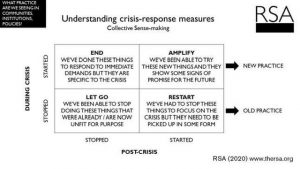Nigel writes…
Sadly, my team was knocked out the of FA cup last weekend. Despite dominating large parts of the game we were out-thought tactically by a very determined Arsenal team. Their manager, Mikel Arteta is new in the leadership role of Head Coach. To make the matter of the defeat worse, it was the manager of my team that apprenticed him. Arteta’s emerging leadership skills outwitted those of his discipler.
Because there are no crowds in the stadia at the moment, you can hear on the TV coverage what the players and managers are saying and shouting at each other during the game. At one point during this game we were able to hear an example of highly astute leadership practice. Like all of the top football teams, Arteta’s Arsenal team are made up from players from all around the world. They are multi-cultural and speak a variety of languages. What was so poignant was that Arteta could be heard during the game shouting instructions and encouragement to his players in their own languages. Effortlessly and fluently, he switched from English, to French, to his native Spanish so that he most effectively led and engaged the players he was seeking to influence in the manner they best understood.
When it comes to fresh expressions and pioneering, and just about everything else in life, we know that effective leadership is key to what happens. Without effective leadership, it is almost impossible for anything to develop. We know from anecdotal evidence and more formal research (E.g. Encountering the Day of Small Things, George Lings, Methodism’s Hidden Harvest) that when it comes to fresh expressions, new forms of leadership have emerged. These are not about what titles a person has, what qualifications they have, what their ministry status is, or what training they have had. It’s about how effective their leadership is in the moment and season; this is particularly the case in this present moment of crisis and uncertainty when we can see who the players are, and who the pretenders are.
As a pioneer and ecclesiastical adventurer, I too often find I speak a different language to those who are part of inherited and attractional models of church. My conviction – like that of Mikel Arteta – is that if we want to be the best we can, we need to speak the languages of those we are seeking to engage. Of course, this understanding is not new. In the book of Acts 2: 1-21, we read how people heard things in their own language. God’s commitment to communicate in people’s native languages.
I’ve recently discovered the theory of spiral dynamics. Space doesn’t allow a full unpacking of this theory, but you can discover more about it HERE – My newly gained insight has taught me afresh, that we often think differently to each other. Spiral dynamics teaches us that we are wired in different ways and this means we might speak different philosophical languages. Those behind the idea have assigned colours to the different ways we might think. In spiral dynamics terms, I – like many pioneers and those in fresh expressions – am green (promoting community, avoiding dogma, post-modern), yellow (fluid, flexible, open to change), and turquoise (holistic, purpose-driven, integrally transcendent). However, I note that many in more inherited and attractionally orientated churches are either blue (liking authority structures, rules, hierarchy) or orange (competitive, materialistic, success driven). This presents a language and a leadership challenge when we seek to communicate with each other; as we perceive things differently.
But here is the thing – I can speak the languages of blue and orange because I live in the worlds where blue and orange are spoken frequently. I have played to the rules of blue. Operated to the materialistic demands of orange. But now, I aspire to the hope of community and common good green. Flex and flow in the chaordic needs of people, project, planet and purpose yellow. Seek the holistic, intuitive, spiritual, expansive big picture of turquoise. Being what is called a ‘spiral wizard’, I can do a little of what Arteta did and what the spirit enabled in Acts 2: speak in different ways to different people in the hope of best engaging them in ways they will best understand. However, those who come from the worlds of blue and orange don’t yet speak yellow, green, and turquoise.
This becomes a problem for me and for other similarly positioned pioneers. We get misunderstood, side-lined, sometimes maligned, and often unfairly judged for speaking a different ecclesiological language. In reality our predicament can be somewhat worse than I describe. The response from those who don’t speak green, yellow or turquoise can be worse than simply not understanding the linguistics. The very words pioneers use can produce such a negative emotional response within that blues and oranges can end up precluding themselves from even hearing what pioneers are trying to say.
I say this not to invoke sympathy or out of a sense of self-pity. It’s more that we need to help those who come from a different worldview and speak a different language to better understand how we yellow, green and turquoise pioneers think, feel and behave.
My fear is that if we can’t manage to do this we will never be able to share the joys and delights of what we see God doing in our culture and language. Those from a blue and orange culture and language risk missing out on what the founder of spiral dynamics thinking, Clare W. Graves, calls the ‘unfolding, emergent, oscillating spiralling process’ that for many of us is akin to an ongoing Pentecost experience … and I don’t want them to miss out.
Dr Nigel Pimlott
Expressing a personal reflection especially for Sunday Papers


